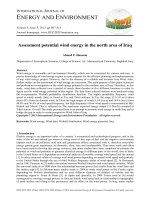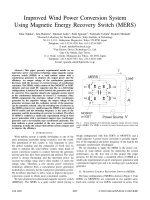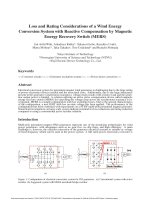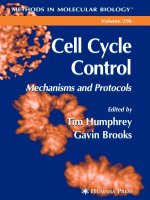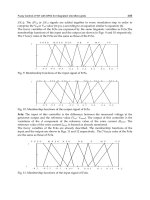15 MPPT CONTROL METHODS IN WIND ENERGY CONVERSION SYSTEMS
Bạn đang xem bản rút gọn của tài liệu. Xem và tải ngay bản đầy đủ của tài liệu tại đây (700.62 KB, 24 trang )
<span class="text_page_counter">Trang 1</span><div class="page_container" data-page="1">
<b>MPPT Control Methods in Wind Energy Conversion Systems </b>
Jogendra Singh Thongam
<small>1</small>and Mohand Ouhrouche
<small>2</small><i><small>1</small></i>
<i>Department of Renewable Energy Systems, STAS Inc. </i>
<i><small>2</small></i>
<i>Electric Machines Identification and Control Laboratory, Department of Applied Sciences, University of Quebec at Chicoutimi Quebec Canada </i>
<b>1. Introduction </b>
Wind energy conversion systems have been attracting wide attention as a renewable energy source due to depleting fossil fuel reserves and environmental concerns as a direct consequence of using fossil fuel and nuclear energy sources. Wind energy, even though abundant, varies continually as wind speed changes throughout the day. The amount of power output from a wind energy conversion system (WECS) depends upon the accuracy with which the peak power points are tracked by the maximum power point tracking (MPPT) controller of the WECS control system irrespective of the type of generator used. This study provides a review of past and present MPPT controllers used for extracting maximum power from the WECS using permanent magnet synchronous generators (PMSG), squirrel cage induction generators (SCIG) and doubly fed induction generator (DFIG). These controllers can be classified into three main control methods, namely tip speed ratio (TSR) control, power signal feedback (PSF) control and hill-climb search (HCS) control. The chapter starts with a brief background of wind energy conversion systems. Then, main MPPT control methods are presented, after which, MPPT controllers used for extracting maximum possible power in WECS are presented.
<b>2. Wind energy background </b>
Power produced by a wind turbine is given by [1] <small>2 3</small> 0.5 ( , )
where R is the turbine radius, <i>v<sub>w</sub></i> is the wind speed, is the air density, <i>C<sub>p</sub></i>is the power coefficient, is the tip speed ratio and is the pitch angle. In this work is set to zero. The tip speed ratio is given by:
</div><span class="text_page_counter">Trang 2</span><div class="page_container" data-page="2"><i>where J is the system inertia, F is the viscous friction coefficient, T</i><small>m</small> is the torque developed by the turbine, T<small>L</small> is the torque due to load which in this case is the generator torque. The target optimum power from a wind turbine can be written as
Fig.1 shows turbine mechanical power as a function of rotor speed at various wind speeds. The power for a certain wind speed is maximum at a certain value of rotor speed called optimum rotor speed<i><small>opt</small></i>. This is the speed which corresponds to optimum tip speed ratio<i><small>opt</small></i>. In order to have maximum possible power, the turbine should always operate at<i><small>opt</small></i>. This is possible by controlling the rotational speed of the turbine so that it always rotates at the optimum speed of rotation.
Fig. 1. Turbine mechanical power as a function of rotor speed for various wind speeds.
<b>3. Maximum power point tracking control </b>
Wind generation system has been attracting wide attention as a renewable energy source due to depleting fossil fuel reserves and environmental concerns as a direct consequence of using fossil fuel and nuclear energy sources. Wind energy, even though abundant, varies
</div><span class="text_page_counter">Trang 3</span><div class="page_container" data-page="3">continually as wind speed changes throughout the day. Amount of power output from a WECS depends upon the accuracy with which the peak power points are tracked by the MPPT controller of the WECS control system irrespective of the type of generator used. The maximum power extraction algorithms researched so far can be classified into three main control methods, namely tip speed ratio (TSR) control, power signal feedback (PSF) control and hill-climb search (HCS) control [2].
The TSR control method regulates the rotational speed of the generator in order to maintain the TSR to an optimum value at which power extracted is maximum. This method requires both the wind speed and the turbine speed to be measured or estimated in addition to requiring the knowledge of optimum TSR of the turbine in order for the system to be able extract maximum possible power. Fig. 2 shows the block diagram of a WECS with TSR control.
Fig. 2. Tip speed ratio control of WECS.
In PSF control, it is required to have the knowledge of the wind turbine’s maximum power curve, and track this curve through its control mechanisms. The maximum power curves need to be obtained via simulations or off-line experiment on individual wind turbines. In this method, reference power is generated either using a recorded maximum power curve or using the mechanical power equation of the wind turbine where wind speed or the rotor speed is used as the input. Fig. 3 shows the block diagram of a WECS with PSF controller for maximum power extraction.
Fig. 3. Power signal feedback control.
</div><span class="text_page_counter">Trang 4</span><div class="page_container" data-page="4">The HCS control algorithm continuously searches for the peak power of the wind turbine. It can overcome some of the common problems normally associated with the other two methods. The tracking algorithm, depending upon the location of the operating point and relation between the changes in power and speed, computes the desired optimum signal in order to drive the system to the point of maximum power. Fig. 4 shows the principle of HCS control and Fig. 5 shows a WECS with HCS controller for tracking maximum power points.
Fig. 4. HCS Control Principle.
Fig. 5. WECS with hill climb search control.
<b>4. MPPT control methods for PMSG based WECS </b>
Permanent Magnet Synchronous Generator is favoured more and more in developing new designs because of higher efficiency, high power density, availability of high-energy permanent magnet material at reasonable price, and possibility of smaller turbine diameter in direct drive applications. Presently, a lot of research efforts are directed towards designing of WECS which is reliable, having low wear and tear, compact, efficient, having low noise and maintenance cost; such a WECS is realisable in the form of a direct drive
<b>PMSG wind energy conversion system. </b>
There are three commonly used configurations for WECS with these machines for converting variable voltage and variable frequency power to a fixed frequency and fixed voltage power. The power electronics converter configurations most commonly used for PMSG WECS are shown in Fig. 6.
</div><span class="text_page_counter">Trang 5</span><div class="page_container" data-page="5"><b>Fig. 6. PMSG wind energy conversion systems </b>
Depending upon the power electronics converter configuration used with a particular PMSG WECS a suitable MPPT controller is developed for its control. All the three methods of MPPT control algorithm are found to be in use for the control of PMSG WECS.
<b>4.1 Tip speed ratio control </b>
A wind speed estimation based TSR control is proposed in [3] in order to track the peak power points. The wind speed is estimated using neural networks, and further, using the estimated wind speed and knowledge of optimal TSR, the optimal rotor speed command is computed. The generated optimal speed command is applied to the speed control loop of the WECS control system. The PI controller controls the actual rotor speed to the desired value by varying the switching ratio of the PWM inverter. The control target of the inverter is the output power delivered to the load. This WECS uses the power converter
</div><span class="text_page_counter">Trang 6</span><div class="page_container" data-page="6">configuration shown in Fig. 6 (a). The block diagram of the ANN-based MPPT controller module is shown in Fig. 7. The inputs to the ANN are the rotor speed <i>ω<small>r</small></i> and mechanical
<i>power P<small>m</small>. The P<small>m</small></i> is obtained using the relation
Fig. 7. ANN-based MPPT control module of turbine rotor speed.
<b>4.2 Power signal feedback </b>
In [4], the turbine power equation is used for obtaining reference power for PSF based MPPT control of PMSG WECS. Fig. 8 shows the block diagram for the PSF control signal generation. Using equation (8) we have:
<i><small>optopt r</small></i>
Fig. 8. Reference power generation for PSF control.
<i>The PSF control block generates the reference power command P<small>ref</small></i>using (8) which is then applied to the grid side converter control system for maximum power extraction.
<b>4.3 Hill climb search control </b>
In [2-17] Hill climb search method of MPPT control for PMSG WECS are proposed. The control algorithm proposed in [2] uses the principle of search-remember-reuse technique. The method uses memory for storing peak power points, obtained during training process, which are used later for tracking maximum power points. The principle behind this algorithm is a search-remember-reuse process. The algorithm will start from an empty intelligent memory with a relatively poor initial performance. During the execution, training
</div><span class="text_page_counter">Trang 7</span><div class="page_container" data-page="7">mode will use the searched data by advanced hill-climb search to gradually train the intelligent memory to record the training experience. The algorithm will reuse the recorded data in application mode for fast execution. This “search-remember- reuse” will repeat itself until an accurate memory of system characteristics is established. Therefore, after the algorithm is adequately trained, its power extraction performance is optimized. Since the intelligent memory is trained on-line during system operation, such a process is also referred as on-line training process. The structure of the advanced hill-climb search control
<i>algorithm is shown in Fig. 9. Every execution cycle starts with sampling of V<small>dc</small> and P<small>0</small></i>, and calculation of their differentials. The mode switch rule directs the control into one of three execution modes, namely initial mode, training mode, and application mode. The inverter
<i>current demand I<small>dm</small></i> is calculated in that mode and fed to the inverter to regulate the system
<i>power output. I<small>dm </small></i>is defined as the requested peak value of the sinusoidal inverter output current. The maximum power error driven mechanism (MPED) provides the system with a preliminary optimized operating point when the intelligent memory is empty. The reference
<i>signal for MPED is the P<small>max</small></i> which can only be reached when wind is sufficiently high. The intelligent memory records the system maximum power points and the corresponding control variables at different operating conditions. The direct current demand control
<i>(DCDC) utilizes the optimized relationship between the V<small>dc</small> and I<small>dm</small></i> recorded by the
<i>intelligent memory, and generates the command I<small>dm</small> based on the present value of V<small>dc</small></i>. For details about the method please refer to [2].
Fig. 9. Structure of advanced hill-climb search
The MPPT control proposed in [5] is based on directly adjusting the dc/dc converter duty cycle D according to the result of the comparison of successive wind generator (WG) output power measurements. Although the variation of wind speed with time is large, the power absorbed by the WG varies relatively slowly because of the slow dynamics of the
<b><small>turbine-Mode Switch Rules </small></b>
</div><span class="text_page_counter">Trang 8</span><div class="page_container" data-page="8">generator system. The problem of maximizing the WG output using the converter duty cycle as a control variable is effectively solved using the steepest ascent method given by
<i>dP dD</i> where D is the dc/dc converter duty cycle. This is possible because power as a function of duty cycle has a single extremum point coinciding with the maximum power point of WG, and the dc/dc converter duty-cycle adjustment according to the control law of (9) ensures convergence to the maximum power point under any wind-speed condition. A HCS control method based on limit cycle is proposed in [6]. The MPPT control is performed via an integrator ramping up or down the current command signal of the grid side converter using the error in the dc link voltage regulated by a boost chopper. The reference current increases till the maximum power is obtained however, if it is increased further then the dc link voltage cannot be kept at constant because the power equilibrium cannot be maintained. Therefore, the dc link voltage begins to decrease and if it goes below a certain limit then, the integrator gain is changed to negative value decreasing the value of reference current. The MPPT control exhibits non linear oscillations about maximum power point called the limit cycle. In this method, the generated output power is automatically maximized by utilizing the inherent limit cycle phenomena of the system itself without requiring any information from the generator side, e.g. rotation speed, torque or instantaneous power etc.
In [7, 8] disturbance injection based HCS is proposed. The control algorithm proposes to inject a sinusoidal perturbation signal to the chopper. Then, the system output power is sampled at π/2 and 3π/2 of each cycle, the difference of which decides about the next perturbation. The method does not require wind speed or rotor speed sensing.
In the HCS method proposed in [9], by controlling the output power as well as adjusting the electrical torque, the speed of the generator is indirectly controlled and then it obtains the optimum speed for driving the power to the maximum point. The maximum power error driven mechanism, operates like a traditional hill-climbing method, drives the output power gradually increasing to its maximum value by regulating the direction of current command according to the power variation trend. The maximum power differential speed control produces an additional step of current command based on the instantaneous difference of generator speeds, so that it can prevent the wind turbine from stalling at the suddenly dropping wind speed and achieve the object of maximum power extraction. It adds a faster control index into the control value which is proposed to be an exponential function of the differential generator speed and therefore it causes sharp increase or decrease in generator current command when wind speed increases or decreases suddenly. The controller generates current command for controlling the grid side converter. The method does not require wind speed measurement.
In [10] a variable tracking step is used to track the maximum power point. The constant step size used in conventional controllers is replaced with a scaled measure of the slope of power with respect to the perturbed generator speed ΔP/Δω. The variable step uses a larger step size
</div><span class="text_page_counter">Trang 9</span><div class="page_container" data-page="9"><i>when the operating point is far away from the peak due to the larger magnitude of P</i>-ω slope and as the peak gets nearer, the step size should automatically approach to zero. The method uses torque current and speed to compute power. The speed step is computed as
In [11, 12] adaptive control algorithm for MPPT control is proposed. The control algorithm allows the generator to track the maximum power points of the wind turbine system under fluctuating wind conditions. The algorithm proposed initiates the TSR control with an approximate optimal TSR value. When the measured wind velocity is found to be stable, the algorithm switches to HCS to search for the true optimal point. When the true peak is reached, a memory table of the optimum generator speed versus the corresponding wind velocity is updated and then, the TSR is corrected. When the wind speed varies, the rotor speed reference is applied from the memory if a recorded data at current wind speed is present in the memory and if not, it is calculated using TSR. The MPPT control signal is given to the boost chopper for tracking the maximum power points. The method requires both wind speed and rotor speed measurement.
In [13] MPPT control of PMSG WECS is implemented via a dc-dc boost converter. The proposed MPPT strategy is based on directly adjusting the dc-dc converter duty cycle according to the result of the comparison of successive WTG output power measurements. The WECS MPPT algorithm operates by constantly perturbing the rectified output voltage
<i>V<small>dc</small></i>of the WECS via the dc-dc boost converter duty cycle and comparing the actual output
<i>power with the previous perturbation sample. If the power is increasing, the perturbation </i>
will continue in the same direction in the following cycle so that the rotor speed will be increased, otherwise the perturbation direction will be inverted. When the optimal rotational speed of the rotor for a specific wind speed is reached, the HCS algorithm will have tracked the maximum power point and then will settle at or around this point. In [14] a buck-boost converter circuit is used to achieve the maximum power control of wind turbine driven PMSG WECS. The PMSG is suitably controlled according to the generator speed and thus the power from a wind turbine settles down on the maximum power point using the proposed MPPT control method. The method does not require the knowledge of wind turbine’s maximum power curve or the information on wind velocity. It uses the dc link power as its input and the output is the chopper duty cycle.
The HCS MPPT control method in [15] uses power as the input and torque as the controller output. The optimum torque output of the controller is applied to the torque control loop of a DTC controlled PMSG. The controller does not require wind speed sensing.
The HCS MPPT control method presented in [16] combines the benefits of two of the commonly used MPPT methods: (i) the tracking method based on the optimum power versus speed characteristic and (ii) the HCS. The algorithm measures generator rotor speed
<i>and computes optimum torque T<small>opt</small></i>, the torque which maximizes power. The actual torque
<i>T<small>t</small></i>is also calculated. For a small error between the optimal and measured torque <i>ΔT, the </i>
system performs a perturb and observe (P&O) process, based on the calculation of actual
<i>power, overlooking the use of the optimum T – ω characteristic. However, if the ΔT exceeds </i>
</div><span class="text_page_counter">Trang 10</span><div class="page_container" data-page="10">a certain limit the duty cycle is commanded according to the optimum characteristic. In other words, the system tracks the maximum power point through a P&O process under
<i>normal circumstances; however, it uses the predefined T – ω characteristic in case the P&O </i>
algorithm is thrown off due to heavy disturbances such as sudden wind speed changes or improper initialization.
Neural networks based MPPT controller is presented in [17]. The method proposed uses Jordan recurrent multilayer ANN with one hidden layer. The weights of the networks are continuously modified by back propagation during the operation of the WECS with online training. The control system continuously searches ways to reach the peak power point. Optimum rotor speed, which is the output of the controller, is used as the reference speed for the vector controlled machine side converter control system.
<b>5. MPPT control methods for SCIG based WECS </b>
The use of induction generators (IG) is advantageous since they are relatively inexpensive, robust, and require low maintenance. The nature of IG is unlike that of PMSG; they need bi-directional power flow in the generator-side converter since they require external reactive power support from the grid. Modern IG WECS are equipped with PWM back-to-back frequency converter which also allows advanced control algorithms to be implemented. However, other converter configurations are possible and can be found in the literature. SCIG WECS with a back-to-back converter configuration is shown in Fig. 10. The MPPT control in such system is realized using the machine side control system. All the existing MPPT control algorithm scan be implemented for the control of IG WECS.
Fig. 10. SCIG WECS
<b>5.1 Tip speed ratio control </b>
In [13, 18, 19], TSR control method of MPPT control for SCIG WECS are presented. In the TSR control method presented in [18] the wind speed is measured for obtaining optimum rotor speed using the value of optimum tip speed ratio. The optimum TSR is obtained from
<i>the turbine’s C<small>p</small>-λ curve. The rotor speed required for implementing speed feed-back control </i>
is estimated using a speed observer. The speed control is exercised using a fuzzy neural network controller.
Wind-speed estimation based MPPT control are proposed in [3, 19]. In [3], an ANN wind speed estimation based TSR control method was used for implementing MPPT control of SCIG WECS. Here, the optimum speed command was generated by the MPPT controller for speed control loop of machine side converter control system enabling the WECS to extract
</div><span class="text_page_counter">Trang 11</span><div class="page_container" data-page="11">optimum energy. The method has been presented in section (4.1). The wind speed estimation method in [19] is based on the theory of support-vector regression (SVR). The inputs to the wind-speed estimator are the wind-turbine power and rotational speed. A specified model, which relates the inputs to the output, is obtained by offline training. Then, the wind speed is determined online from the instantaneous inputs. The estimated wind speed is used for MPPT control of SCIG WECS.
<b>5.2 Power signal feedback </b>
In [20], fuzzy logic controller is used to track the maximum power point. The method uses wind speed as the input in order to generate reference power signal. Maximum power
<i>output P<small>max</small> of the WECS at different wind velocity v<small>w</small></i> is computed and the data obtained is
<i>used to relate P<small>max</small> to v<small>w</small></i> using polynomial curve fit as given by
<i>The actual power output of the rectifier P<small>o</small> is compared to the reference power P<small>ref</small></i> and any mismatch is used by the fuzzy logic controller to change the modulation index M for the grid side converter control.
<b>5.3 Hill climb search control </b>
HCS control of SCIG WECS are presented in [21, 22]. In [21], a fuzzy logic based HCS controller for MPPT control is proposed. The block diagram of the fuzzy controller is shown in Fig. 11. In the proposed method, the controller, using Po as input generates at its output the optimum rotor speed. Further, the controller uses rotor speed in order to reduce sensitivity to speed variation. The increments or decrements in output power due to an increment or decrement in speed is estimated. If change in power is positive with last <i>P</i><sub>0</sub>
positive change in speed , indicated in Fig. 11 by<i><sub>r</sub>L</i><i><small>r</small></i>
<i>pu</i> , the search is continued in the same direction. If, on the other hand, causes<i><small>r</small></i> , the direction of search is <i>P</i><small>0</small> reversed. The variables ,<i>P</i><small>0</small> and<i><small>r</small>L</i> are described by membership functions and rule <i><small>r</small></i>table. In order to avoid getting trapped in local minima, the output is added to some <i><small>r</small></i>
amount of <i>L</i> in order to give some momentum and continue the search. The scale factors <i><small>r</small></i>
KPO and KWR are generated as a function of generator speed so that the control becomes somewhat insensitive to speed variation. For details please refer to [21].
In [22], a fuzzy logic control is applied to generate the generator reference speed, which tracks the maximum power point at varying wind speeds. The principle of the FLC is to perturb the generator reference speed and to estimate the corresponding change of output
<i>power P<small>0</small></i>. If the output power increases with the last increment, the searching process continues in the same direction. On the other hand, if the speed increment reduces the output power, the direction of the searching is reversed. The block diagram of the proposed controller is shown in Fig. 12. The fuzzy logic controller is efficient to track the maximum power point, especially in case of frequently changing wind conditions. The controller tracks the maximum power point and extracts the maximum output power under varying wind
</div><span class="text_page_counter">Trang 12</span><div class="page_container" data-page="12">Fig. 11. Block diagram of fuzzy logic MPPT controller
Fig. 12. Fuzzy MPPT controller
conditions. Two inputs and <i><sub>r</sub></i><sup>*</sup> are used as the control input signals and the output of <i>P</i><small>0</small> the controller is the new speed reference speed which, after adding with previous speed command, forms the present reference speed. For more details, please refer to [22].
<b>6. MPPT control methods for DFIG based WECS </b>
The PMSG WECS and SCIG WECS have the disadvantages of having power converter rated
<i>at 1 p.u. of total system power making them more expensive. Inverter output filters and EMI filters are rated for 1 p.u. output power, making the filter design difficult and costly. </i>
Moreover, converter efficiency plays an important role in total system efficiency over the entire operating range. WECS with DFIG uses back to back converter configuration as is shown in Fig. 13. The power rating of such converter is lower than the machine total rating as the converter does not have to transfer the complete power developed by the DFIG. Such WECS has reduced inverter cost, as the inverter rating is typically 25% of total system power, while the speed range of variable speed WECS is 33% around the synchronous speed. It also has reduced cost of the inverter filters and EMI filters, because filters are rated
</div>
